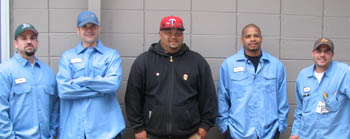

By Haley Dahlgard
 Apprentice electricians (from l-r) Sergio Gonzalez, Scott Kucala, Jerome Wiggins, David Davis, Chris Nelson
Apprentice electricians (from l-r) Sergio Gonzalez, Scott Kucala, Jerome Wiggins, David Davis, Chris Nelson
Electrician apprentices have been working at Berkeley Lab in the Facilities Division after an agreement was signed by the Berkeley Lab and the Alameda County Electrical Joint Apprenticeship and Training Committee (JATC) in October. It is the first time any trade at the Lab has had an apprentice program and it is proving to be successful.
The Lab provides a rare environment for electricians to work. “The apprentices may not find themselves working around research equipment and the Lab environment outside of Berkeley Lab,” says Jim Murphy, an apprentice supervisor. “Here there are a lot more operational facilities and occupied spaces to work around.” A few of the apprentices, including Scott Kucala, work at the Advance Light Source and like the exposure to different science projects. “There are different types of equipment involved, including supply grounding jumpers and power supply. I like seeing a variety of science and being a part of it,” Kucala said.
There is a culture of mentorship at the Lab, where the journeymen act as mentors to the apprentices and give them a lot of one-on-one attention. “The mentorship is a key factor for safety,” says Bill Mattson, an apprentice supervisor. Safety, perhaps, has been emphasized the most, and is also what sets the Lab apart from the outside. Jerome Wiggins, an apprentice, raved about the safety procedures here. “The LOTO procedure is the best I’ve seen in the area. It’s phenomenal. I’ve never seen it in such detail.”
The apprentices must complete five years of training and classes before they get certified. During the five-year span, they work for about five to eight different contractors and can work at the Lab for up to one year. During these five years, the apprentices take a minimum of 900 hours of classroom related instruction. Christopher Nelson, an apprentice, explained how it is tough to go to school and work at the same time, however the apprentices benefit by having hands-on experiences rather than just reading material. “Everyday I’m learning something different. It’s been a great experience so far,” he said.
Not only are the apprentices benefiting from their time at the Lab, but the Lab also benefits from having the apprentices. The apprentices can be seen as possible future employees at the Lab. David Davis, one of the apprentices, explained how the apprentices provide fresh minds and may provide the journeymen electricians with new ways of doing things.
Mattson says the apprentices have been great and are very eager. “Employees were hesitant when we first proposed the program, but the apprentices won them over. Steve Cooper, an apprentice supervisor, says they’re motivated, follow directions, and is completely satisfied with their performance. The apprentices really enjoy working here. It’s a win-win.” Kucala said his experience has been great. “It’s helpful to have good and nice people around. They keep you in the loop. Outside of the Lab, supervisors don’t explain much. The attitude here is nicer. It’s a good atmosphere.”
With the tough economy, many apprentices are out of work, so the apprentices are delighted to be working at the Lab. Byron Benton, JATC Apprenticeship Coordinator, said the program, “allows men and women an opportunity to live and work in the community they grew up in. The program provides local residents an opportunity to have a career for a lifetime,” he said.
In fact, all the apprentices expressed interest in the possibility of working at the Lab in their future. “It’s a good place to someday come back to,” says Sergio Gonzalez, an apprentice. “They’re likely to come back to us and we’ll get a well-rounded pool of applicants whom we feel can greatly contribute to the success of the Lab,” says Murphy.
Today at Berkeley Lab is produced by Public Affairs' Communications Department